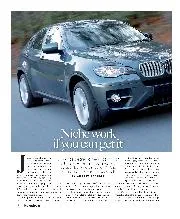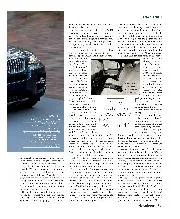

Niche work if you can get it
BMW has created a new class of car with its X6 – the first ‘Sports Activity Coupé’. But who asked for it? And will the niche outlast the product? By…
The racing record of the BMW M3, the original E30-shape version, makes for very impressive reading. This machine captured World, European, British, German and Italian touring car titles to name just a few. It triumphed in the Spa 24 Hours four times and its Nürburgring equivalent on five occasions. Not bad for a car that for much of its career was competing against machinery with significantly more power.
The M3 had its roots in the early 1980s, when BMW Motorsport engine guru Paul Rosche sliced two cylinders off the M1 sports car’s straight-six powerplant to create a 16-valve four pot. What became the S14B23 engine found its way into a new car designed at BMW Motorsport with competition at the forefront of its mind. So much so that few panels, apart from the roof and the doors, were carried over from a standard E30 shell.

The car was launched at the Frankfurt show in 1985 and the production of 5000 cars, necessary for Group A homologation, was completed for the 1987 season. It wasn’t aimed at the top class of touring car racing, but the secondary division.
Yet so good was this class contender that on its day it could beat the Ford Sierra RS Cosworth outright. In the World Rally Championship it even beat four-wheel-drive machinery – witness Bernard Béguin’s famous 1987 Tour de Corse victory.
The arrival of the M3 coincided with what turned out to be a one-off season for the original World Touring Car Championship. The ‘Bimmer’ won outright four times over the course of the season — not counting the victory in the Monza opener lost in the scrutineering bay to a roof metal thickness snag — and Roberto Ravaglia claimed the title.
“Everything to build one came in crates, down to the last washer”
It was the first of many for both the M3 and Ravaglia. The Italian was at the vanguard of BMW’s campaigns with the car, sealing his place as one of the all-time touring car greats with a further four titles across the European Touring Car Championship, the DTM and Italian Superturismo.
But the M3 deserves its place as one of history’s greatest touring cars for more than just the successes it garnered, in the hands of factory teams such as Schnitzer, Bigazzi and CiBiEmme. The car was also a bedrock of the privateer racing scene.
The M3 wasn’t quite an off-the-peg racer, more a kind of Airfix kit without the decals. Everything else for a team to build up a winning touring car arrived in crates from Munich along with a bare shell.

“The kit came with everything down to the last washer,” remembers Malcolm Swetnam, team manager on the Prodrive-run BMW squad that won the 1988 BTCC title with Frank Sytner. “And woe betide you if there was a washer left over at the end. You’d have to find where that washer went. It was ruthlessly efficient, typically German.”
BMW improved the M3 over time, always with racing in mind, with a trio of evo versions culminating in the Sport Evolution of 1990. Conceived for the DTM, the engine was taken out to 2.5 litres and big 18-inch wheels were also homologated.
The importance of the M3 stretched into its dotage. It was an important flag in the sand on the creation of the touring car landscape that followed on from Group A. When the category that eventually became known as Super Touring was formulated by the brains of the BTCC for the 1991 season, the M3 in two-litre spec provided much of the field for the fledgling category.
BMW M3
• Price new N/A
• Price now £90-140,000
• Engine 2.3-litre, 16-valve straight-four
• Power 300bhp
• Major titles WTCC (1987), ETCC (1988), DTM (1989), BTCC (1988 & ’91), Italian Superturismo (1987, ’89, ’90 & ’91)
• Verdict Maybe the greatest touring car of all time
The compact rocket is starting to soar in value
It’s hard to imagine a car that embodies the modern classic sector more than the E30 BMW M3. It had all the elements of a future classic; a premium brand, sector-leading performance, and a motor sport heritage.
What was different about the E30 M3 was the timeframe in which the model came to the fore – prices started to climb at a higher rate than would previously have been expected for a late ’80s/early ’90s model that wasn’t a Ferrari. What is unusual in the current market, where some prices have cooled, is that last October a fully restored M3 with immaculate history sold at auction for £135,000 – the highest price for a road going E30 M3 for the past five years and smashing the reserve of £85-95,000.
Examples of race-spec M3s at auction are a little rarer than road-going ones. However, far and away the highest price paid recently at auction for an E30 M3 (road or race) was the car used by Tim Harvey during the 1991 British Touring Car Championship.
It failed to sell when previously offered in 2011, with an estimate of £86-100,000. But in 2017 it went for a final sum of £146,250.
Another surprise in the E30 market is that the prices are far and away higher than those experienced in 2014 and 2015.
Robert Johnson, Classic and Sports Finance
